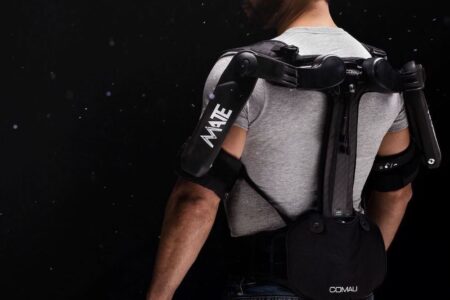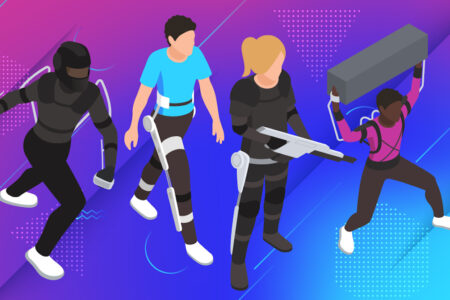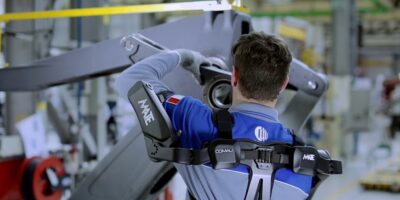Editors Blog – Exoskeletons – taking the strain
Exoskeletons can do more than support muscles and limbs, with the addition of haptic technology they can rehabilitate patients and entertain gamers, writes Caroline Hayes
Repeated lifting is easy with a helping hand from an exoskeleton. Picture: Comau
When it comes to heavy lifting, an exoskeleton turns an member of staff into a superhero, lifting heavy weights with ease, as the exoskeleton supports the back and muscles reducing strain and fatigue.
I wore one at the Hannover Fair BC (Before Covid) and was amazed at the effortless boost it gave. The harness was not cumbersome and I was genuinely astonished that someone like me, who has less upper arm strength than a sloth, was able to lift heavy objects repeatedly without breaking a sweat.
I was interested, therefore, to hear that Comau has partnered with Germany’s oldest university, Heidelberg University to find new application areas for wearable robotics in industrial settings.
Comau, the Italian industrial automation and systems company, claims that its MATE passive mechanical exoskeleton was the first to be awarded the Ergonomic Assessment Work Sheet (EAWS) certification by Italy’s Ergo Foundation. MATE reduces the biomechanical overload of the upper limbs for workers performing daily tasks which require flexion-extension of the arms.
Measuring benefits
EAWS is a measure of how the exoskeleton can reduce the physical stress of employees and to reduce the risk of them developing musculoskeletal injuries as a result of their work and over a period of time.
MATE recorded an average decrease in ergonomic scores of 30 per cent for the shoulder in static position and 25 per cent for dynamic movements of the shoulder, even when considering the handling of small loads.
This certification proves Comau meets the expectations of companies that need to understand concretely how an industrial exoskeleton like MATE can impact their operations. More specifically, to what degree it can reduce the physical stress of their employees, helping them to carry out their tasks in a more comfortable way, reducing the risk of developing musculoskeletal pathologies over time.
MATE was developed by Comau in partnership with IUVO, a spin-off of the BioRobotics Institute of the Scuola Superiore Sant’Anna in Pisa, and Icelandic orthopaedic device company, ÖSSUR.
Stepping up
The research project, run by Heidelberg University with the collaboration of IUVO, is to use MATE-XT, which is ruggedised for indoor and outdoor use. It withstands resists water, dust, UV light and a wider temperature range than the MATE. Its frame is slimmer and uses a lighter carbon fibre structure that uses breathable fabrics. It uses a passive, spring-based mechanisms and has eight assistance levels to meet the wearer’s needs.

The collaboration seeks to quantify how MATE-XT reduces stress and where else it can be used. Picture: Comau
The assisted support reduces muscle fatigue during overhead and repetitive operations. The Heidelberg study will examine the degree to which the MATE-XT exoskeleton can reduce physical stress during strenuous tasks involving repetitive shoulder flexion movements, putting the exoskeleton through its paces in new industries and outdoor environments, while verifying users’ learning and motor adaptation speeds.
“The collaboration with Heidelberg University underscores our commitment to evolve the use of adaptive wearable technologies through the combination of empirically-backed research, advanced robotics and biomedical expertise,” said Giuseppe Colombina, leader of the Comau HUMANufacturing Innovation Hub leader and CEO of IUVO.
Provisional testing of the MATE-XT the exoskeleton can help workers increase accuracy during overhead tasks by 27 per cent and execution speed by 10 cent, compared with not wearing an exoskeleton. It can also reduce cycle times by at least five per cent to increase precision, quality, and performance, suggest Comau.
“The proliferation of wearable robotic devices represents a long-term, sustainable answer to ensure wellbeing in the workplace,” said Nicola Vitiello, PhD, associate professor at Scuola Superiore Sant’Anna and founding partner of IUVO.
In 2020, Comau forecast a five-year CAGR of up to 40 per cent and said that the industrial sector is expected to account for nearly half of this growth.
Other use cases
Exoskeletons are also used in medical and gaming applications and both are likely to see significant growht. Analyst Technavio has forecast that medical exoskeletons will see a CAGR of 29 per cent between 2020 and 2024.
For market research company, IDTechEx, it will be adding haptics that has potential to not only expand into full-body equipment, but also to find further applications in healthcare and new applications in gaming.

Adding haptic technology to exoskeletons opens up industrial, medical and gaming applications. Picture: IDTechEx
Haptic technology, the recognition of an action, with a sensation of touch, will be a game-changer, says the analyst company. A full haptic suit, for example, can improve the movements of a patient with Parkinson’s disease and help in the rehabilitation of stroke and spinal injury patients.
As well as shoulder and chest or full body exoskeletons, companies are developing exoskeleton gloves which can be used by stroke patients to detect movement in the unaffected arm and assist the same movement in the other hand which has been paralysed by the stroke, as part of the rehabilitation process. Another exoskeleton glove could have a software library of movements which it can assist and support the stroke patient to perform.
Tactile haptics in an exokskeleton could indicate interaction with an object – perhaps vibration as contact is made. If a kinaesthetic haptic could directly block the user from overlapping with a solid object, the user would not be able to place their hand within a virtual object which is supposed to be solid. “Combined with virtual reality goggles, these exoskeletons could contribute in the future to a fully immersive gaming experience,” said IDTechEx.




